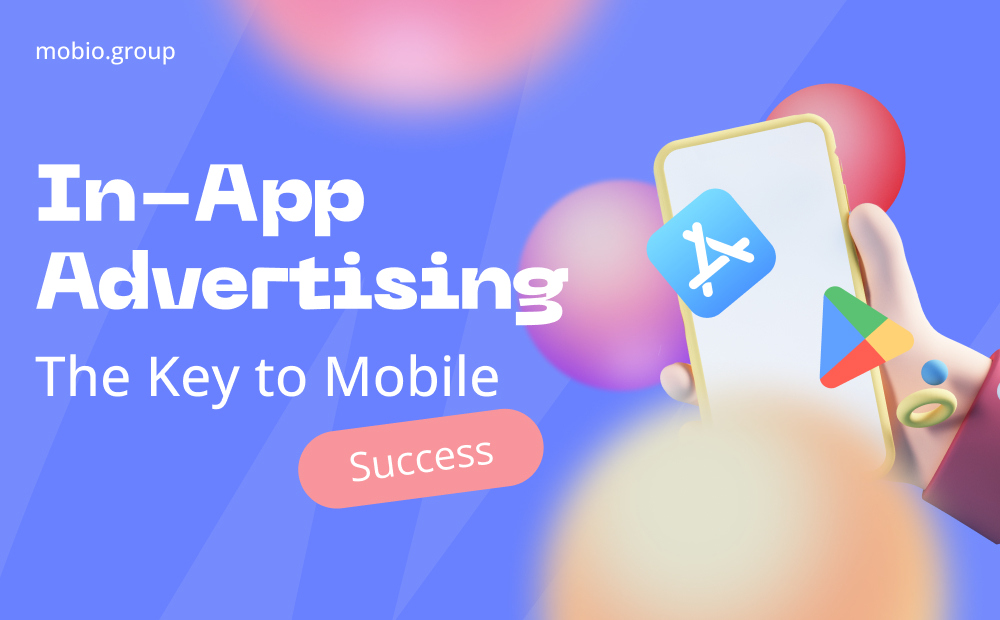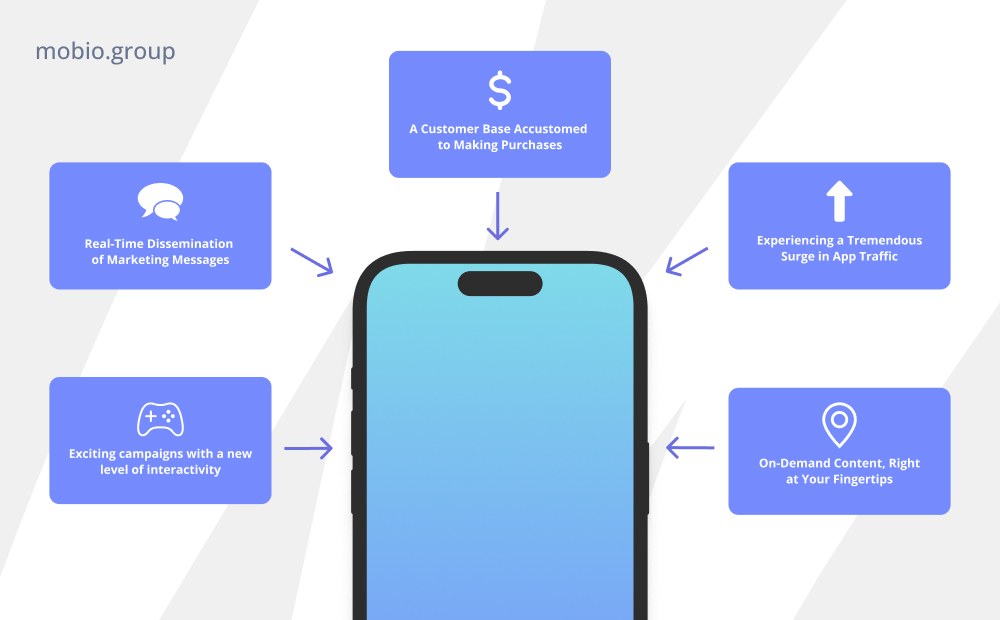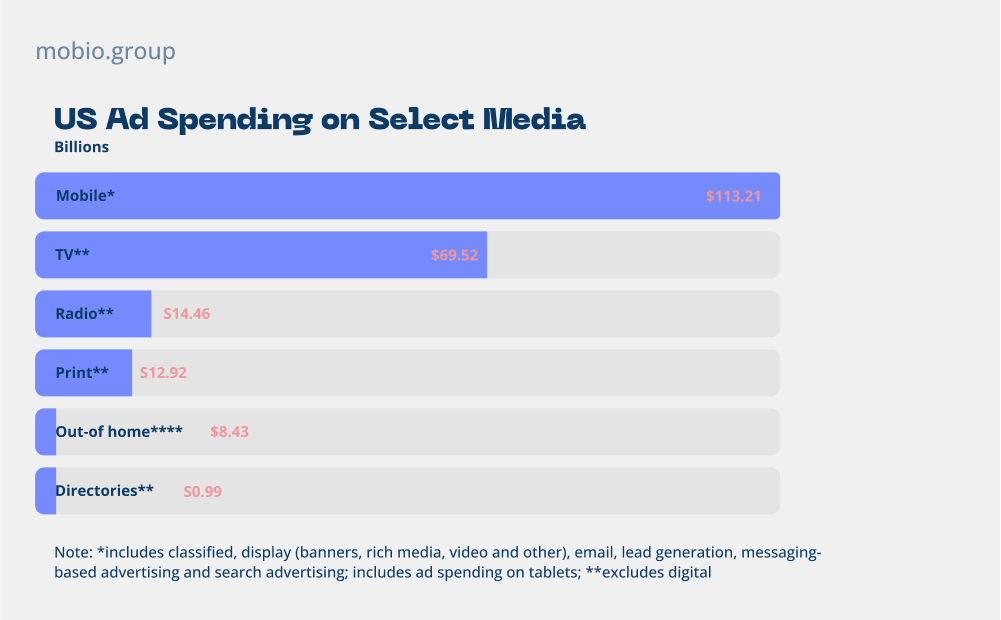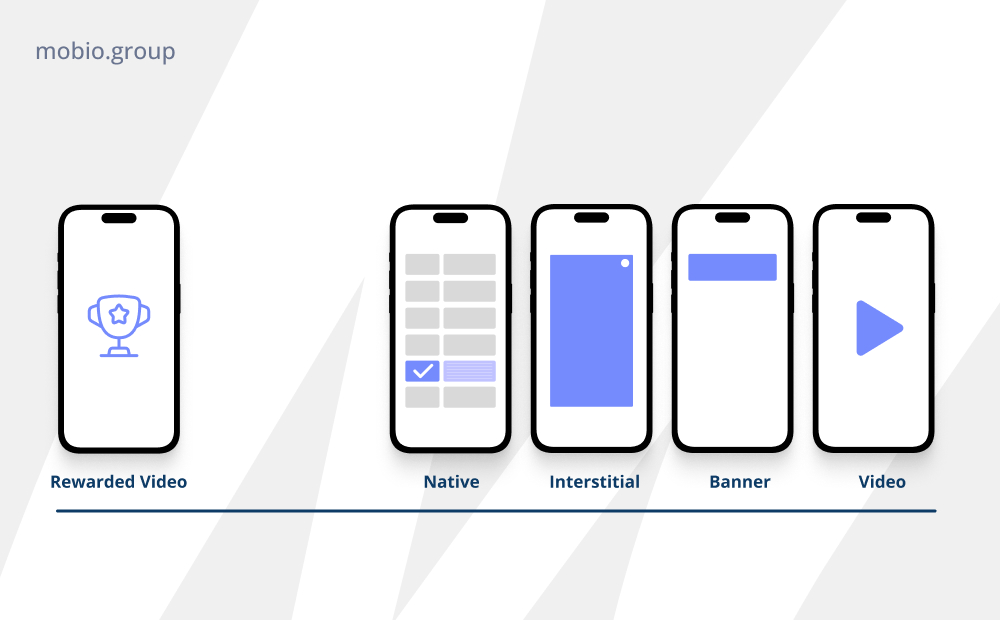In-App Advertising: Tips & Trends | Mobio Group

In today’s digital age, smartphones have become an integral part of our lives, as have the apps we use on a daily basis. As their popularity grows, advertisers and marketers have found a valuable way to engage their target audience — In-App Advertising. In this article, Mobio Group will look at the development of In-App, its importance in the digital landscape, benefits, challenges and prospects.
The Development of Advertising in Apps
The advent of mobile apps has ushered in a new era of convenience, connectivity and communication. With millions of users interacting with apps on their smartphones and tablets every day, it’s no surprise that advertisers have recognized the huge potential to reach consumers directly through their mobile devices and have seized the opportunity to capture the attention of this vast in-app audience.
The main advantage of mobile apps over traditional advertising channels is privacy, as smartphones are personal devices that people carry with them everywhere, giving advertisers a unique opportunity to connect with users in real-time and in a more personal context. This shift from desktops to mobile devices has forced marketers to rethink their strategies.
Traditional advertising such as TV spots, print ads, and billboards were designed for mass audiences and had limited targeting options. With the advent of mobile-first strategies, advertisers are now able to use more sophisticated data-driven approaches to tailor their messages to specific user segments. Mobile ads can be customized based on factors such as location, demographics, behaviors and interests, ensuring that relevant ads are delivered at the right time.
In addition, the effectiveness of traditional advertising has been declining in recent years due to changing consumer behavior. People are increasingly consuming content on mobile devices, and they are more willing to accept ads that fit seamlessly into their in-app experience than interruptive or intrusive formats.

The Main Reasons for the Popularity of In-App
Several factors have contributed to In-App’s rapid growth in popularity among advertisers:
1. Wider reach
Mobile apps have a large and diverse user base, giving advertisers unprecedented access to a huge audience across different demographics and geographies.
2. Advanced targeting
In-app advertising allows for a variety of targeting options, giving advertisers the ability to deliver personalized and relevant ads, which in turn leads to increased engagement and conversions.
3. Immersive user experience
In-app ads can be seamlessly integrated into the app interface. This increases the likelihood of users interacting with the ads, creating an immersive ad experience that feels natural and unobtrusive to the user when using the app as a whole.
4. Measurable results
Digital advertising has extensive analytics and tracking capabilities, allowing advertisers to evaluate the effectiveness of their campaigns in real time and optimize them based on specific data.
5. Cost-effective
Compared to traditional advertising channels, in-app advertising is often a more cost-effective solution, making it affordable for companies of all sizes.
Advertisers are increasingly investing in this form of advertising, as numerous statistics also confirm:

Types of Advertising in Apps
In-App advertising offers different formats, each designed for specific purposes and user experiences. Its main types are:
⦾ Banner Ads
One of the earliest and most common forms of in-app advertising. It is a block of image, animation, video, or text that is placed at the top, bottom, or sides of the app interface and appears on the screen when the app is open.
⦾ Interstitial Ads
A full-screen interstitial ad that is placed at natural transition points. Typically, these ads appear at moments such as completing a level in a game, switching between application screens, or after certain user actions. Thanks to the immersive effect, cross-page ads are effective in capturing the user’s attention, making them a suitable option for showcasing visual effects or video content.
⦾ Native Ads
These are ads that harmonize with the app content, echoing its design and style and creating a sense of continuity, making them more organic and less intrusive than traditional ads.
⦾ Video Ads
This is one of the most compelling and visually appealing marketing tools. Videos can either be in the form of streaming ads that play before, during, or after app content, or they can be in the form of reward video ads that offer users an in-app incentive, such as in-app currency or enhanced features for watching such a video.
⦾ Playable Ads
These ads are interactive previews that allow users to familiarize themselves with the gameplay or features of a mobile app before deciding to download it. These interactive ads are especially popular in the gaming industry where users can “try out” the game, increasing the chances of attracting interested and relevant users.

Selecting the Format of Advertising in Apps
The choice of format for in-app advertising depends on several factors, including:
1. Campaign objectives
The primary objective of the advertising campaign plays an important role in determining the format. If, for example, the goal is to increase brand awareness, then video ads or cross-page ads that can grab the attention of users may be preferred. On the other hand, if the goal is to encourage app downloads, game ads may be a suitable option.
2. Target Audience
Certain formats may resonate better with specific demographics or segments of users, which requires a clear understanding of the preferences and behaviors of your target audience.
3. Content and context of the app
The nature of the app definitely influences the choice of ad format. In apps with long user sessions and natural transition points, interstitial (cross-page) ads may be more effective, while apps with short sessions may opt for banner ads that don’t disrupt the flow and occupy a smaller portion of the screen.
4. User experience
Ad formats that integrate seamlessly into the app and don’t disrupt the user experience are more likely to be better received by users, which is why native ads are one of the most popular.
5. Ad Performance Metrics
Advertisers should analyze historical data and key metrics for each format to understand which ones have produced the best results in terms of click-through rate (CTR), conversions, and user engagement.
6. App Monetization Strategy
Different formats may be better suited to certain monetization strategies, such as cost-per-click (CPC) or cost-per-install (CPI) models. Although most advertisers opt for cost-per-action (CPA) when working with In-App format (CPA).
7. Budget and Resources
Some formats, such as video or interactive ads, may require higher production costs and resources, so you should always consider your budget and financial capabilities when choosing a format.
8. App industry and category
Gaming apps often use reward video ads to incentivize users, while content-focused apps may use native ads for organic integration.
9. Platform and device
Consideration of platform (iOS or Android) and device capabilities (smartphones, tablets) is necessary to ensure compatibility and optimal performance of the chosen ad format.
Challenges and Prospects for Advertising in Apps
In-app advertising has become a source of revenue for app developers and a great marketing tool for advertisers. However, like any advertising platform, in-app advertising comes with its own challenges and opportunities.
⦿ In-app advertising challenges:
Ad fatigue and user experience
Users today are overwhelmed or annoyed by the frequency and intrusiveness of ads that interfere with their work or entertainment. By monitoring your audience’s behavior and paying attention to the user experience, you can avoid decreased engagement and negative attitudes toward the app and ads.
Ad blockers and privacy issues
Because in-app advertising is becoming more prevalent, users are increasingly turning to ad blocking solutions to get rid of intrusive ads. Blockers pose a serious problem for advertisers as they limit the reach of their campaigns and reduce ad revenue. In addition, privacy concerns related to data collection and ad targeting have raised ethical and regulatory issues, requiring transparent communication with users regarding the use of personal data.
Measurement and attribution
Accurately measuring the effectiveness of in-app advertising can be challenging due to various attribution issues. Tracking conversions and attributing them to specific ad campaigns across devices and points of interaction is quite a challenge. Advertisers need comprehensive measurement solutions that provide insight into the entire customer journey to make informed decisions about their campaigns, and this requires budgetary investment.
⦿ Perspectives on in-app advertising:
Personalization and targeting improvements
As technology and data analytics continue to advance, the prospects for personalized and targeted advertising in apps look promising. Using advanced data analytics and machine learning, advertisers can deliver relevant and personalized ads to individual users, resulting in increased audience engagement and improved ad effectiveness.
Interactive and immersive advertising
The future of in-app advertising lies in creating interactive and immersive ads. Augmented reality (AR), virtual reality (VR) and gamification are expected to diversify in-app advertising more, allowing brands to engage users in engaging ways.
Integration with new technologies
In-app advertising can easily integrate with new technologies such as voice assistants and smart devices, and in-app advertising with Internet of Things (IoT) devices will further expand advertising opportunities and allow brands to reach users from different touchpoints.
Advanced measurement and attribution models
New advances in measurement solutions will help alleviate the challenges of accurately tracking ad effectiveness. Multi-device and multi-touch attribution models will provide a holistic view of interactions in the user journey and help allocate advertising budgets more effectively.
A Proprietary In-App Traffic Platform Feedwise
Feedwise introduces an in-app traffic platform designed to help advertisers and app owners navigate the world of digital advertising with ease. Our platform provides a complete solution to increase user engagement, improve ad effectiveness and achieve in-app advertising success. We offer:
⦿ Advanced targeting and user information
The Feedwise platform allows you to precisely target the right audience with advanced data analytics and machine learning, gaining insights into user demographics, behaviors, and interests to show personalized and relevant ads that truly resonate with users.
⦿ Full integration and a variety of ad formats
Our team prioritizes user experience by seamlessly integrating unobtrusive ad formats into the app interface. Our goal is to provide a positive and engaging advertising experience that captures users’ attention without disrupting their use of the app.
⦿ Real-time performance analytics
Key Performance Indicators (KPIs) are easily accessible, allowing advertisers to make data-driven decisions and optimize their campaigns on the fly. With useful information at their fingertips, advertisers can continuously improve their strategies and achieve higher ROI.
⦿ Campaign Optimization
Feedwise’s in-app traffic platform offers robust A/B testing capabilities, allowing advertisers to compare different targeting criteria, gaining valuable insights into what resonates best with their audience. The platform’s sophisticated optimization algorithms automatically allocate budget and impressions to the most effective ads, maximizing overall campaign performance.
⦿ Fraud detection and brand safety measures
Brand safety and protection from ad fraud is a top priority for the Feedwise platform. Advanced algorithms and third-party integrations detect and prevent fraudulent activity, protecting advertisers from wasted ad spend and maintaining the integrity of their campaigns. With brand safety measures in place, advertisers can focus on attracting genuine and interested users.
⦿ Customizing conversion sources based on appropriate traffic volume
This includes utilizing both internal traffic buying within the app ecosystem and external sources, such as ad networks and programmatic exchanges, to expand reach and effectively target new audiences.
In-app advertising today is undergoing a transformation, embracing innovative technologies and trends that are redefining user engagement and interaction with brands. An element of interactivity and excitement is enabling emerging trends such as augmented (AR) and virtual (VR) reality, while CPA networks are enabling automation and efficiency in the buying and selling of advertising. As these innovations continue to shape the future, in-app advertising offers a convenient and profitable way for advertisers and app owners to connect with their target audience.
Maximizing ad success and unlocking the potential of personalized advertising, full integration, and data-driven optimization is possible with our Feedwise platform. Whether you’re just starting out or looking to expand your business, we’re here to share our expertise and support to ensure your app gets maximum user response.


